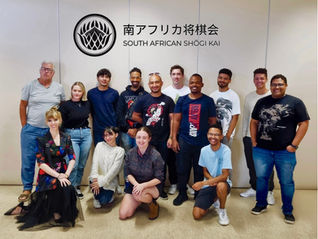Japanese Folklore #4 | 天狗 (Tengu)
- ケイトリン

- Apr 17, 2024
- 6 min read
Updated: Jul 8, 2024

In a bustling town nestled among the rolling hills of old Japan, there lived a young boy named Hiro, whose days were spent in diligent service to a prosperous merchant family. Hiro's chores ranged from sweeping the courtyard to assisting with the stock. He enjoyed his work.
One day Hiro's dedication caught the eye of his master, who, in a gesture of appreciation, bestowed upon him a precious gift—a brand new pair of geta, finely crafted and polished to a gleaming shine which reflected the day's fast fading light. Eyes wide with wonder and gratitude, Hiro clutched the wooden sandals close to his chest, already envisioning the proud strides he would take in them.
Yet, as evening descended and the day's tasks came to an end, Hiro's excitement was met with a chilling warning from his master's lips. "Listen well, Hiro," the master intoned gravely. "It is dangerous to don those shoes now. If you dare to wear those geta so late at night, a spirit may take you away."
A shiver of fear crept down Hiro's spine, but the allure of his new footwear proved too great to resist. Under the cover of darkness, and safely beyond the watchful gaze of his merchant master, Hiro proudly slipped the geta onto his feet, the wood cool against his skin as he ventured out into the night. Unbeknownst to Hiro, he was not alone.
As he strolled through the quiet streets, admiring the elegance of the rhythmic clack-clack of his steps, a sudden gust of wind stirred the air around him. From the shadows emerged a figure unlike any Hiro had ever seen — a towering man with a long nose and wings unfurled from his back, his presence both ominous and mesmerising. "Young one," the figure spoke, his voice carrying the sound of leaves on the wind. "Get on my back, and I will take you to a good place."
Compelled by an unseen force, Hiro obeyed, his senses overwhelmed by a whirlwind of sensation as he found himself lifted into the air, carried upon the creature's avian back. The wind was chilling as it whipped at his clothing. He struggled to keep a firm hold on his new geta and fear began to settle in his heart. Then darkness tugged at mind's edge, finally enveloping Hiro in an abyss of oblivion.
The next day, Hiro did not come to work. Day turned to night, and night to day, and the village lived in the shadow of his absence. Desperate whispers began to fill the air, rumours swirling like leaves caught in a tempest, as a frantic search party scoured the town in search of the missing boy.
Then, just as hope began to wane and despair threatened to consume them all, a miracle unfolded on a weather-beaten bridge at the distant edge of town. There, beneath the pale light of the moon, stood Hiro, his form haggard and weary, yet unmistakably alive... his small form clutching his beloved geta sandals.
They gathered him up and whisked him home. In trembling tones, Hiro recounted the events that had transpired—the encounter with the creature, the journey into the unknown, and his inexplicable return to familiar ground.
“The next thing I realised, I was standing there on the bridge.” He gazed thoughtfully at his geta, still clutched in his arms.
"They say that it was a tengu."
What is a Japanese Tengu?

Almost certainly derived from their Chinese antecedents, tian-gou, Tengu are a Japanese creature of myth and legend known for their anthropomorphic avian appearance. There are two kinds of tengu, the first of which being the karasu tengu, literally a “crow" tengu. This is a birdlike creature with wings, beaked mouth, and the ability to fly. Although named after a crow, they more often assume the appearance of kites or other birds of prey. The karasu tengu are very territorial and will protect the forest areas in which they dwell. They have skills with weapons and were known to train samurai warriors.
The second type of tengu, which may well have evolved from its more bird-like counterpart, is the daitengu, or 'greater tengu'. These yōkai, also know as hanadaka, take the form of a tall, humanoid figure dressed in the style of a Buddhist monk, or other spiritual practitioner. The defining feature of the daitengu, however, is their long, bulbous, red nose – which is said to have evolved from a beak – as well as their large wings. This form of tengu is often depicted with red skin and wearing gigantic wooden clogs on their feet. Some tales even tell of shape shifting, telepathy and telekinesis. Daitengu are often accompanied by karasu tengu, who act as a kind of lieutenant in many tengu tales. They are known to disdain vanity and will teach arrogant people a lesson by stealing victims and depositing them far away, disoriented and perhaps a little more humble.

Popularised as mysterious figures who often resided in the mountainous regions of Japan, these creatures were thought to be the post-death incarnations of emperors or dead warriors, usually people with arrogant dispositions. Their bird-like features and malevolent spirits often descended from the mountains they inhabited to punish and torment people. They aren't necessarily bad though.
Throughout history, Tengu have played multifaceted roles in Japanese mythology. Revered as protectors of the mountains and forests, they are also known for their mischievous nature and penchant for causing trouble. Legends depict them as skilled warriors, masters of martial arts, and cunning tricksters, showcasing their complex and intriguing personas. It is famously said that the tengu – these masters of secret martial arts techniques – once took pity on and trained Minamoto no Yoshitsune, one of the great warriors of Japanese history. They decided to assist him after realising that he was training to avenge the death of his father.

Japanese Buddhism had a harsher view of Tengu, and related them to the spirit of ma, or evil, which is said to hinder a person on their path to enlightenment. To embrace the spirit of the tengu was not necessarily a symbol of evil though. Many monks who failed to resist temptation embraced what became known as the concept of Tengu-do, lit. 'The Way of Tengu'. These monks may not have been able to walk their own path to enlightenment, but they often helped others in their own journeys. Even so, that doesn't mean it was a popular moniker... Referring to a monk from another temple as a 'tengu' was a means of vilifying them and insinuating that their teachings were hazardous or deceitful.
The word 'tengu' itself comes from the kanji for 'heavenly' (天) & 'dog/puppy' (狗). This initially referred to an enormous 'dog-shaped' meteor that fell to earth and made a terrible sound as it did so. This event can be traced back to the Nihonshoki, in an entry for the year 637, in which it is recorded that “a great star floated from East to West, and there was a noise like that of thunder.” A monk later went on to explain that this was no star from the sky, but a celestial dog with a bark like thunder; a new demon in their pantheon. Why this particular name became associated with the tengu of Japanese myth and legend is because the karasu tengu's Chinese antecedents, tian-gou, were traditionally described as having the head of a dog, the hands and torso of a man, and the wings and lower body of a bird. Over time – despite being known as a celestial dog – they lost their canine features and developed a beak instead!

Tengu continue to impact the modern world through various aspects of Japanese culture. From traditional arts like Noh theatre, where Tengu characters often feature prominently, to modern media such as anime and manga (e.g. Tengu Buranchi – a supernatural tengu chef in a mystical hotel), their presence is deeply ingrained in Japan's artistic heritage. Their symbolism embodies themes of strength, wisdom, and spiritual transformation, making them a captivating subject of study and inspiration. Japan's know 'soft power' of international influence continues to spread these tales through various incarnations. Even popular video games, such as Ghost of Tsushima and Final Fantasy XIV, feature some formidable tengu.
In conclusion, the world of Tengu folklore offers a captivating glimpse into Japan's rich mythological heritage. These solitary guardians of the mountains, masters of martial arts, and symbols of righteousness deepen our understanding of Japan's cultural heritage and the profound interconnection between language and legend. For in the shadows of the night, where dreams and nightmares intertwine, the line between folklore and truth blurs into whispers on the wind. We'll leave you with this... If ever you do find yourself confronted with a tengu, just remember: The longer the nose, the stronger the tengu.
Ready to embark on a linguistic and cultural odyssey? Enroll in Nihongo no Niwa’s Japanese language courses today and unlock the magic of Japan’s fascinating heritage! 🎌








Comments